As a child, I treasured the nature stories of Thornton W Burgess. His characters had distinctive personalities. Peter Rabbit, the impetuous and inquisitive hero, was pursued by crafty Reddy Fox and took the sage advice of Grandfather Frog. (Click to learn more about how I loved it when my Dad read me the stories: A Blue Jay Named Sammy)
Of course we adults should not engage in anthropomorphism, but I could not help myself as I reviewed the photos I took during a 25 minute observation of the local Bald Eagle nest. We do not have a nest camera, but based upon the behavior of the adults, our ground observers were quite certain that at least one eaglet had hatched during the previous week or so.
On the day prior to my visit a strong cold front had produced thunderstorms and high winds. There was the possibility that the nest may have suffered some damage, but it seemed to be intact.
There was a great deal going on, but I had not seen the beginning and I had to leave before the end of the story. It was cold by Florida standards (62 degrees F/16.6 degrees C), overcast and very windy-- certainly not weather for T-shirt and shorts.
My major concern was that I saw no eaglet and there was no evidence that one was being nurtured.
Eagles are incapable of changing their expressions and we do not understand their language. Their actions are cloaked in the mystery of consciousness which permeates the natural world.
Despite my inability to know the minds or the motivation of what I saw when I reviewed over 200 photos taken during that brief encounter, here is my fantasy. Call it a soap opera or a telenovela, but please do not accept it at face value. (Click on photos to display larger images)
I arrive at nest at 9:25 AM. The female (Jewel) is sitting up and moving her head down into the nest. At first I think she may be tending to an eaglet, but to my surprise she picks up a large stick and attempts to move it.
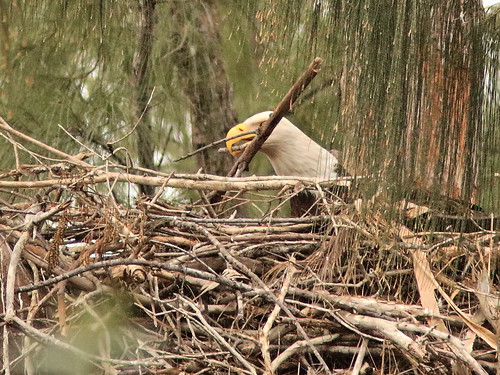
She looks up and suddenly the male (Pride) flies in from the left (east):
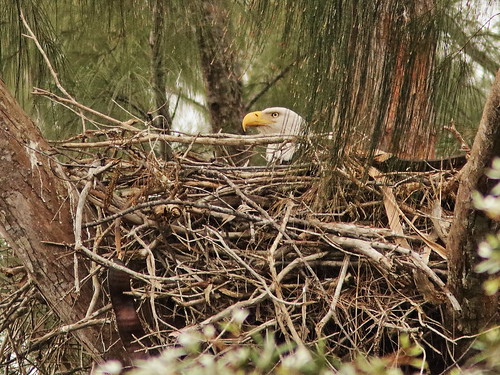

He grasps the same large branch and also tries to rearrange it as Jewel crouches down. Is she sheltering an eaglet?

Jewel stays down low in the nest, and Pride suddenly rises up to the branch on the right...
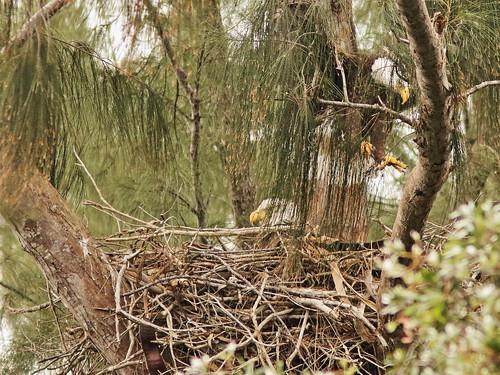
...then Jewel flies off:
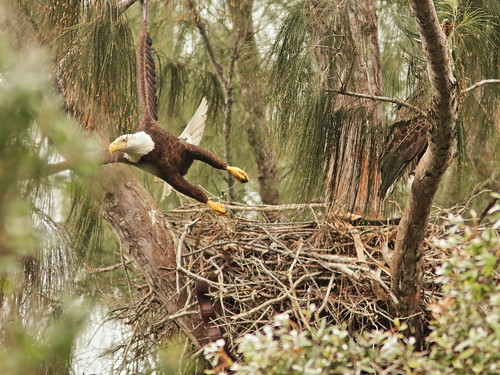
Pride quickly covers the nest, but Jewel returns only about 2 minutes later, carrying a very large fresh pine bough. Pride is thinking, "Do we really need this? She is becoming a branch-aholic!"
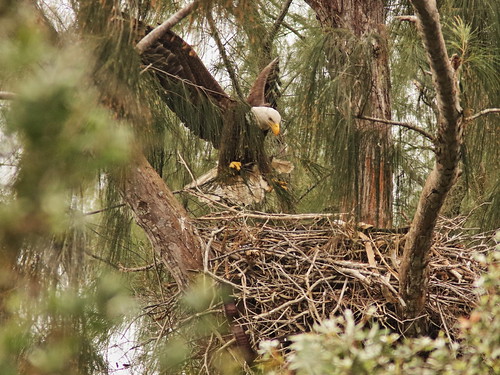
She struggles to get the new branch all the way into the nest as Pride hunkers down and tries to stay out of her way:
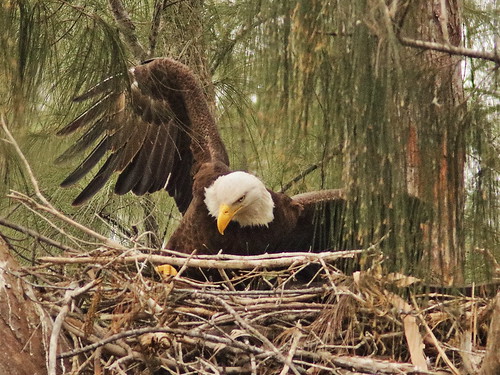
Pride finally decides he had better fly up next to the nest to give her room as she continues to maneuver the branch:
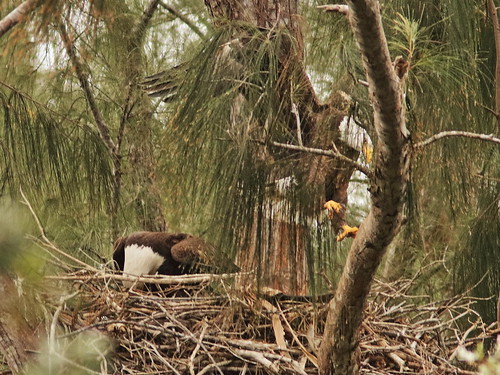
Jewel struggles with the fresh branch:
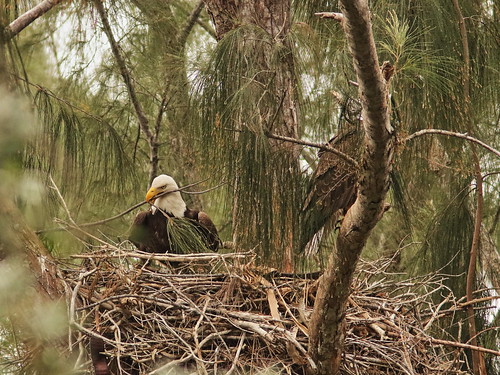
She looks up at Pride as if asking for help:
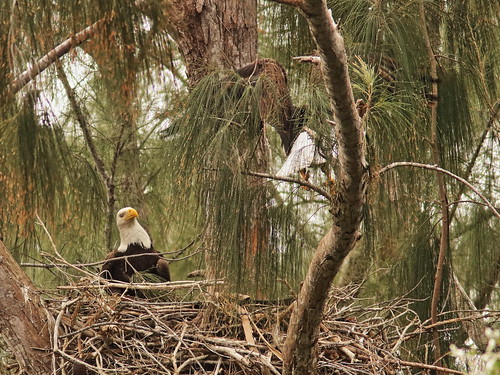
So, Pride flies down and joins her (he is to the right). It looks as if they are ready to cooperate on the project...


...but they seem to disagree:

Then they ponder their next move:
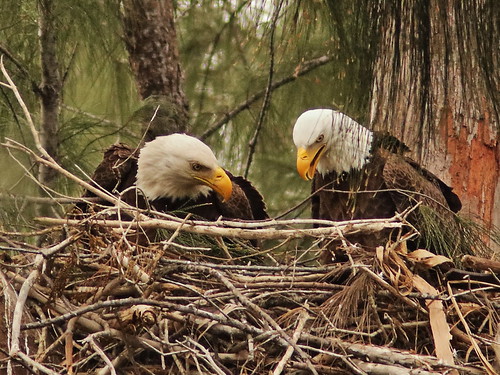
Pride says "I was only trying to help:"
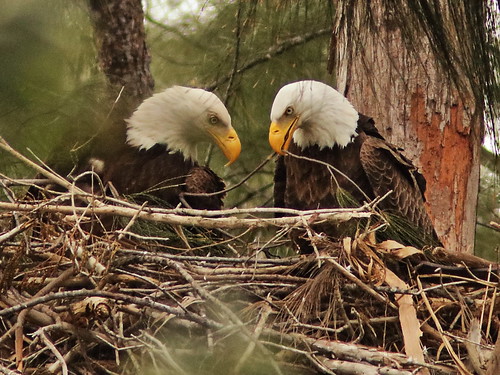
Jewel tells him, "Drop that stick NOW!" Pride closes his protective "third eyelid" (nictitating membrane):

Jewel finally tugs the very long stick into the nest while Pride stays low...

...but soon feels he must help:
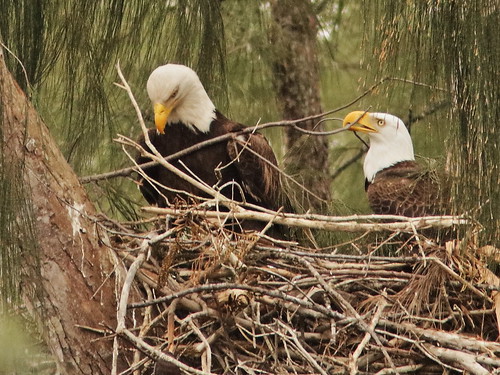
Their efforts are poorly coordinated:
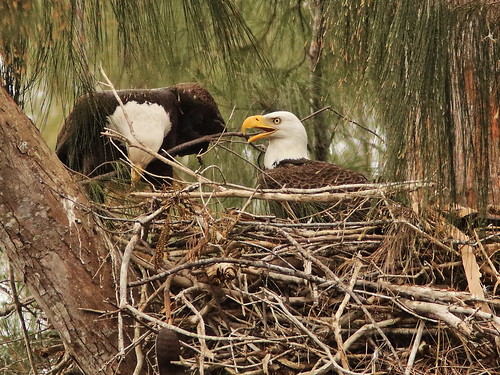
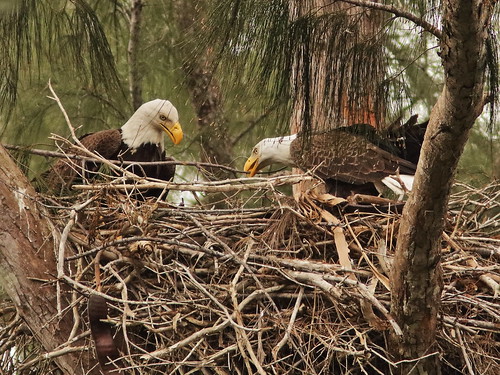
Pride whispers, "Why don't we just give up?"
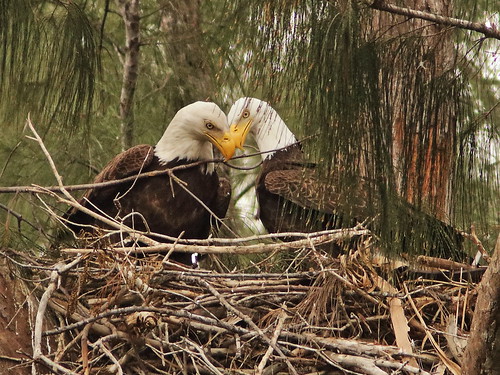
Oh no, not another scolding! The neighbors (including me) hear the screaming:

"Aw, let's make up!"
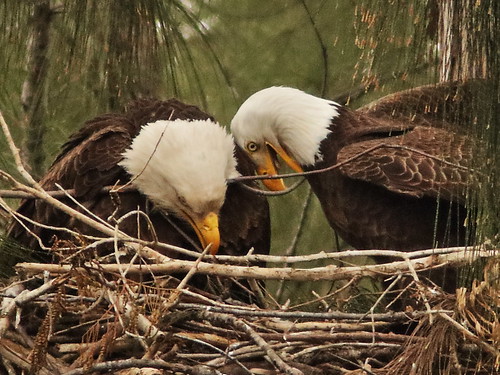
"I don't think she is in a forgiving mood":

Pride hops up to roost and decides to watch from a distance:
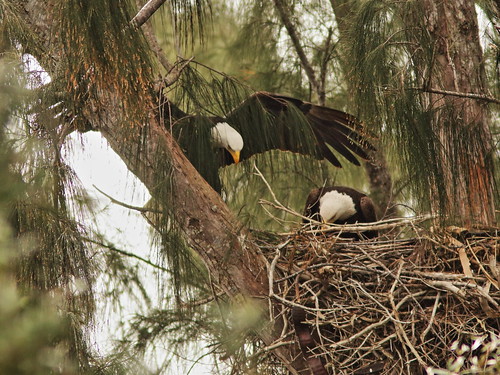
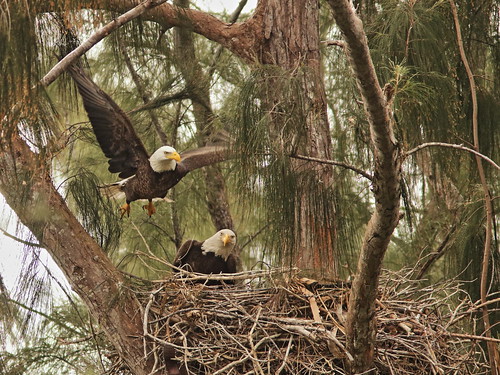
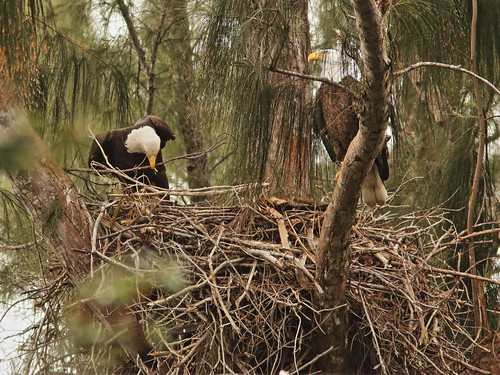
= = = = = = =
Their confrontations were quite noisy. Their vocal interactions may well be friendly bonding behavior. However, nothing indicated that an eaglet was being tended or fed. Chilled to the bone, I had to leave after observing for only 25 minutes.
The eagles still had not incorporated the large fresh branch into the nest structure. We often see the eagles bring fresh foliage to the nest when there are eaglets present. Rather than removing all debris from the nest, they may "sweep it under the rug," I was left with uncertainty about the fate of the eaglet, but later that day they were feeding two still-unseen eaglets. Close watching is needed!
ADDENDUM: After I posted this morning we got our first views of two little eaglets in the nest. Here is the larger one:
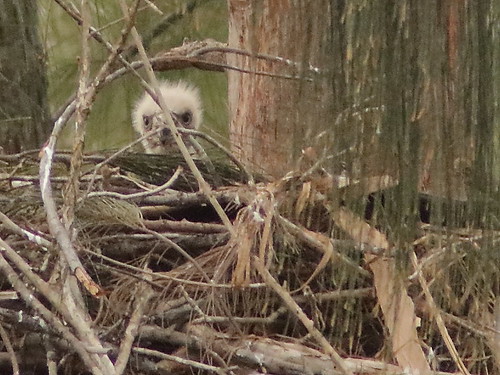 This past week's changing skies--
Wolf Moon setting on January 21:
This past week's changing skies--
Wolf Moon setting on January 21:
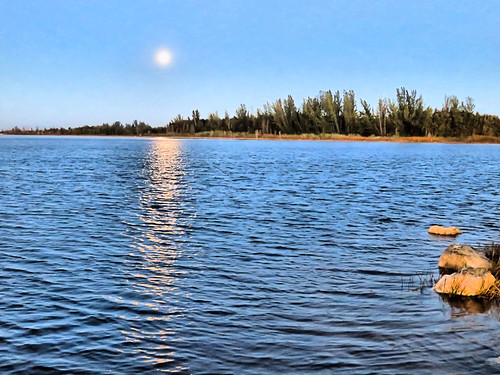 Cold front approaching January 23:
Cold front approaching January 23:

= = = = = = = = = = = = = = =
Linking to Misty's CAMERA CRITTERS,
Linking to Eileen's SATURDAY'S CRITTERS,
Linking to SKYWATCH FRIDAY by Yogi, Sylvia and Sandy
Linking to WEEKEND REFLECTIONS by James
Linking to BirdD'Pot by Anni
Linking to Our World Tuesday by Lady Fi
Linking to Wild Bird Wednesday by Stewart
Linking to Wordless Wednesday (on Tuesday) by NC Sue
Linking to ALL SEASONS by Jesh
________________________________________________
Please visit the links to all these memes to see some excellent photos on display
________________________________________________
Photographing birds in flight has always been a challenge for me. Slow-moving targets are not too difficult to keep in sight, but framing them in the viewfinder is only the first step in the process. They must also be kept in focus and the exposure must compensate for the brightness of the subject and the intensity of light in the background.
The pink sky is bright, causing the camera to "squint," so the exposure must be manually increased to keep the Great Egret from being darkly shadowed:
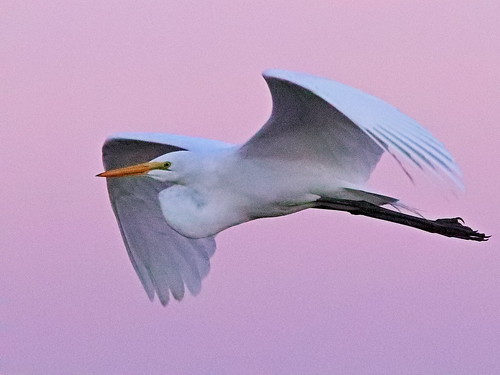
The blue water is darker, and the camera tries to compensate by increasing the exposure. This tendency must be reigned in to keep from over-exposing the white bird:
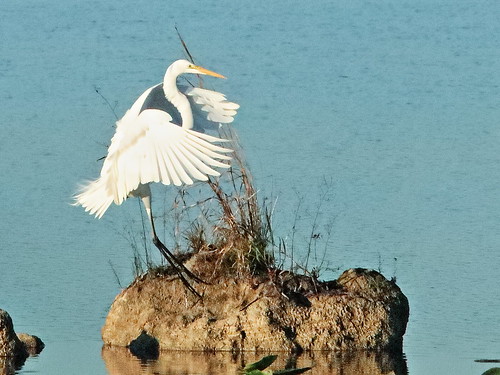
With small birds perched in the foliage, the camera tends to take care of all this automatically. I usually just set the aperture as wide as possible, to isolate the subject from distracting objects in the background. Birds in groups or in flight are not as accommodating, so the aperture must be narrowed to allow a greater depth of sharp focus, as was necessary with these White Ibises:
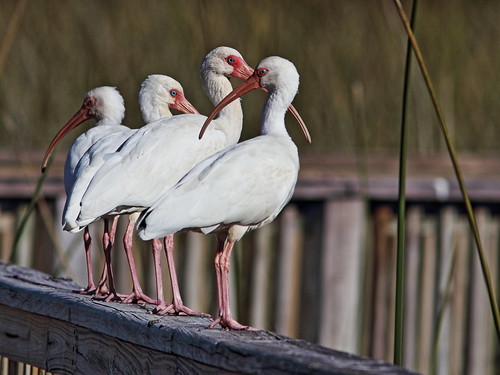
A dark and a white bird against the morning sky-- a Little Blue Heron had a close encounter with a Great Egret:
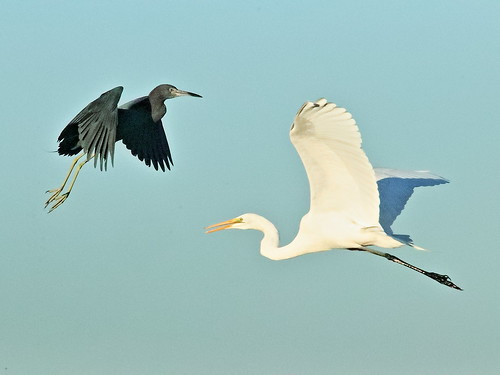
Black birds in flight are particularly troublesome, as their plumage provides little contrast to show off their feather patterns. Reflected sunshine and pure luck allowed me this shot of a Double-crested Cormorant:
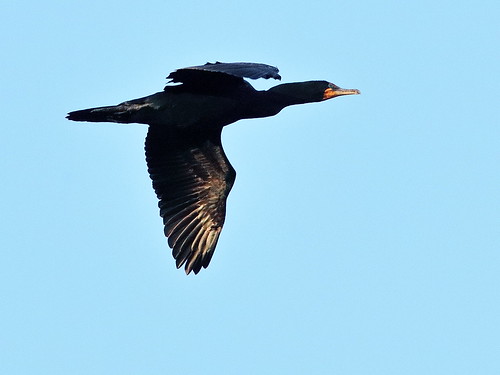
A Red-winged Blackbird puffed up his feathers to catch the light:
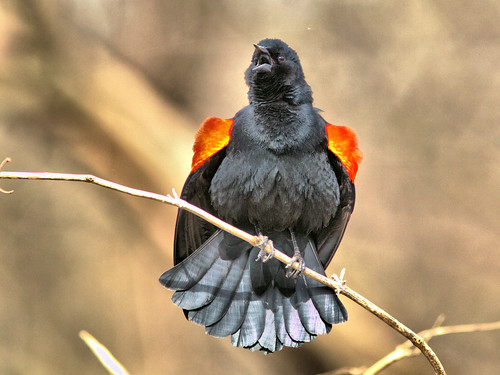
Direct sunlight reveals the iridescence of a Common Grackle...
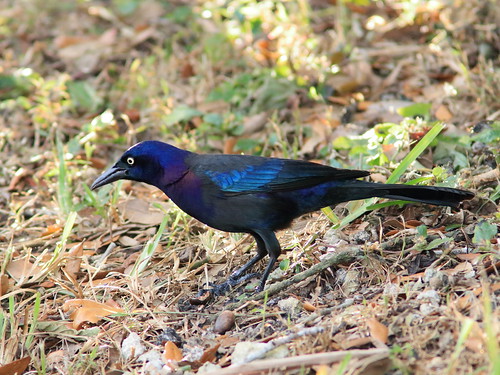
...and a Boat-tailed Grackle:
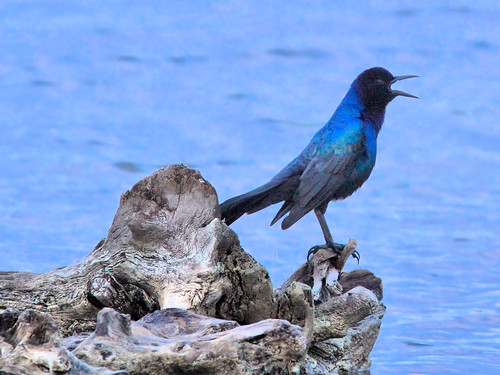
White birds sometimes show up best when they are illuminated from the side or even slightly from behind:
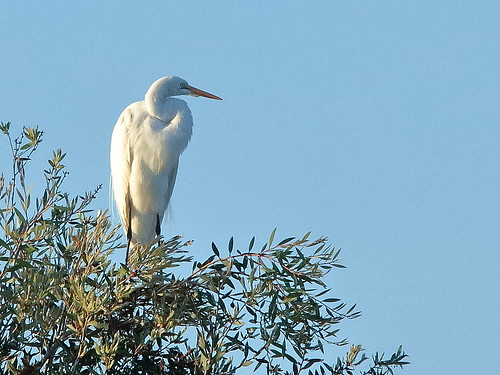
The sky has presented some interesting sights this month. Since we walk out into the wetlands in pre-dawn darkness, we are aware of the movements of celestial objects-- the Moon, planets and bright stars.
Lately we have watched Venus move towards the eastern horizon. On the morning of January 2, the waning crescent Moon was aligned with Venus and Jupiter.
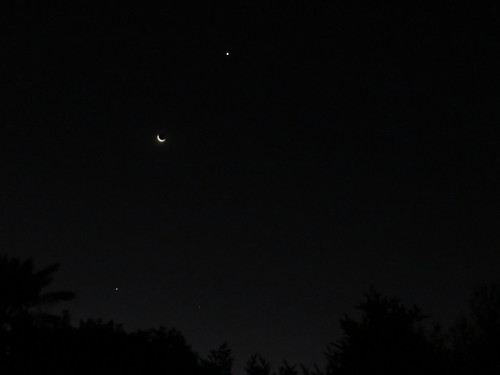
Both planets brightened up as they moved away behind the sun, appearing to move closer together. Actually, the distance between them is never less than 365 million miles. Venus is much closer to the sun and moves along its 422.5 million mile orbit at 78,337 mph (35.02 km/second). Jupiter moves more slowly, at 29,236 mph (13.07 km/second), along its huge 3 billion mile orbit and takes 4331 days to circle the sun.
On January 17, they shone brightly before sunrise:
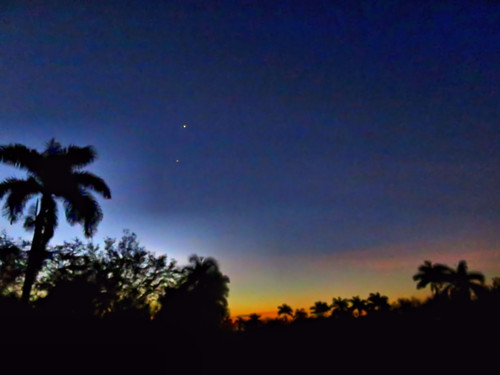
This week we witnessed a "double feature," first a full eclipse of the Moon on January 20. The Wolf Moon rose over our back yard:
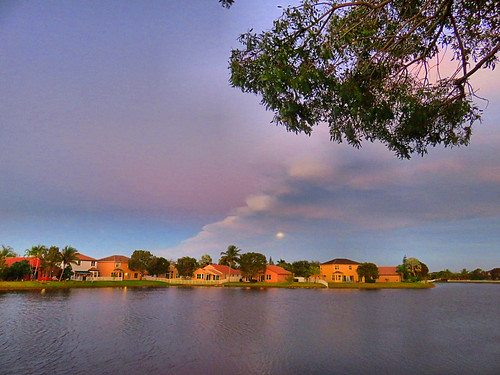 My hand-held images are not very crisp:
My hand-held images are not very crisp:
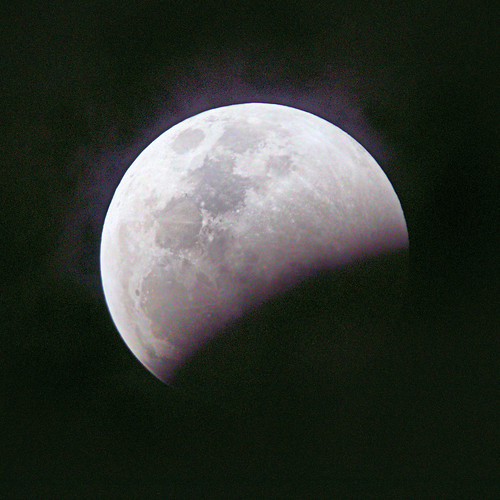
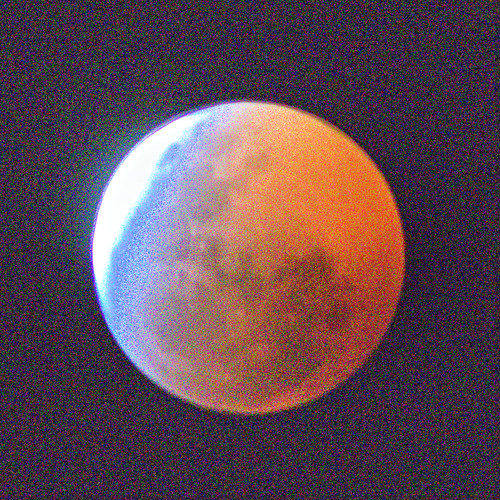
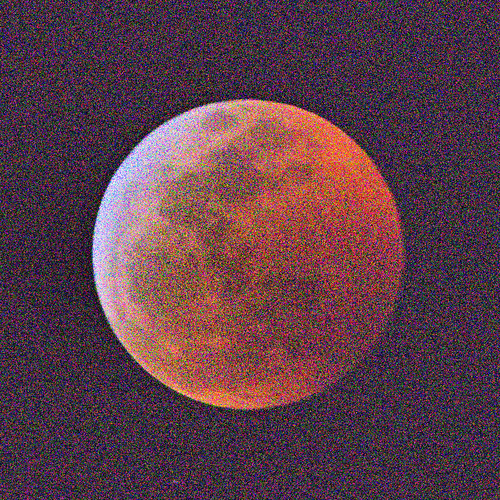
Then, stormy skies caused us to miss the conjunction of Venus and Jupiter, when they would be horizontally aligned. Their conjunction on January 22 would bring them almost 2 degrees apart, about the width of 5 full Moons. Here they were on January 21:
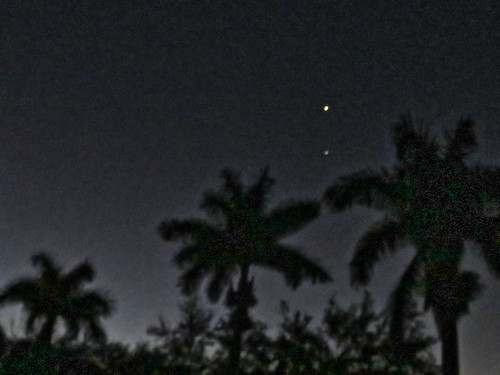
The morning after the conjunction (January 23) was also overcast, and they briefly peeked out from behind the clouds. Now Venus had moved beneath Jupiter:

= = = = = = = = = = = = = = =
Linking to Misty's CAMERA CRITTERS,
Linking to Eileen's SATURDAY'S CRITTERS,
Linking to SKYWATCH FRIDAY by Yogi, Sylvia and Sandy
Linking to WEEKEND REFLECTIONS by James
Linking to BirdD'Pot by Anni
Linking to Our World Tuesday by Lady Fi
Linking to Wild Bird Wednesday by Stewart
Linking to Wordless Wednesday (on Tuesday) by NC Sue
Linking to ALL SEASONS by Jesh
________________________________________________
Please visit the links to all these memes to see some excellent photos on display
________________________________________________
Our local pair of Bald Eagles share responsibility for incubating the eggs, the first of which was laid around December 9 or 10. The female usually sits on them overnight and takes turns with the male during the day. On the morning of December 27 the male (Pride) took over incubation duties and his mate (Jewel) stretched her wings and circled overhead:
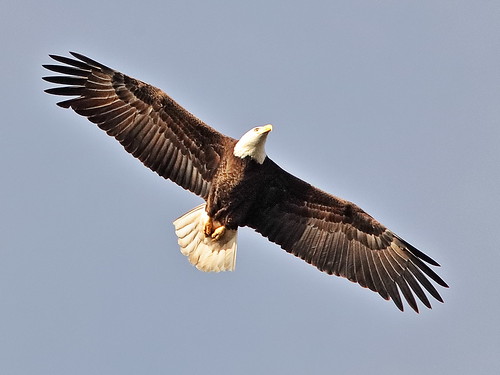
First one, and then a flock of Tree Swallows joined her. They did not attack or disturb her, but just floated around in circles with her:
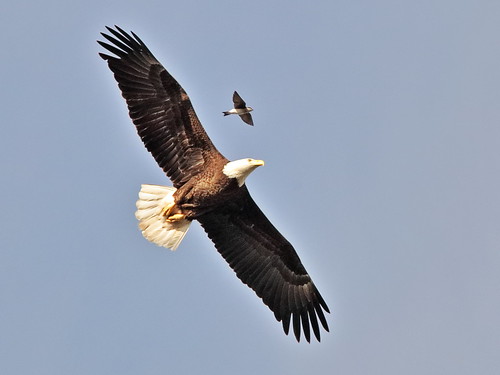
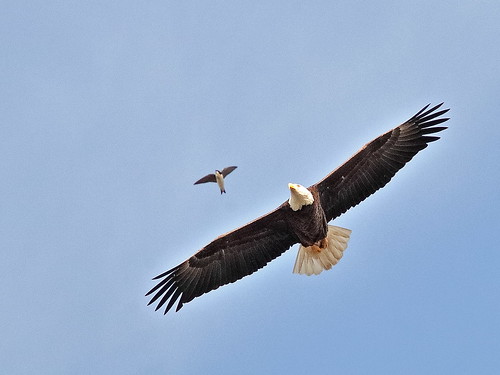

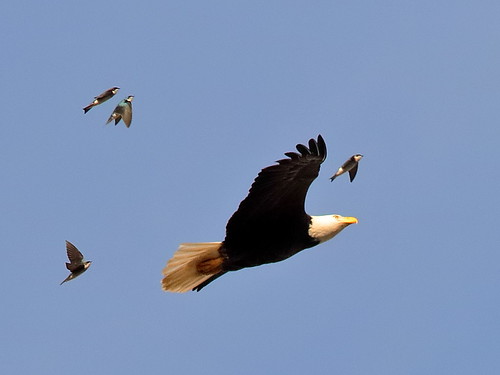
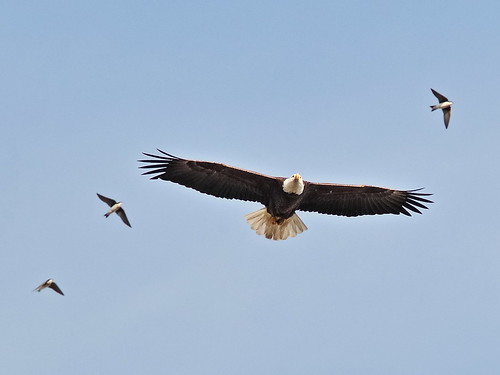
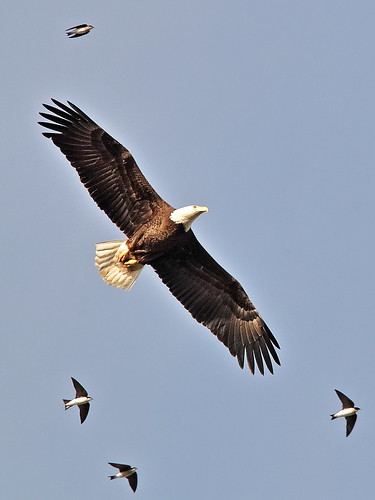
One may ponder the reason for this behavior. The swallows are migrants from the north and they have no territory to defend. Did the swallows perceive a threat? If so, there was no sign of this, as they glided effortlessly with the large bird and rotated together, gaining altitude before departing. Perhaps heat from the pavement of the roadway created a local updraft, and all simply took advantage of it. For me, the uplifting beauty of nature was a sight to behold and enjoy.
A Turkey Vulture also rode on the rising currents. Its wingspan is about 6 feet, about a foot less than that of the female eagle. Its tail is long but its neck is short. From a distance it may almost appears headless. Its silvery flight feathers contrast with the darker leading edge of the wing:
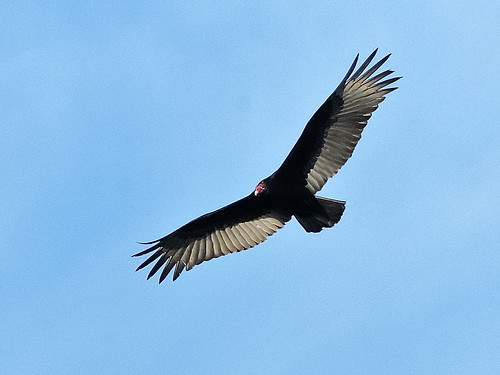
Flocks of Black Vultures were also present. Smaller than Turkey Vultures, they look "front-heavy" with short tails and they extend their necks in flight.

Black Vultures have whitish wingtips and relatively shorter wings (4.5 to 5.5 feet) and must flap often and strongly to gain altitude:
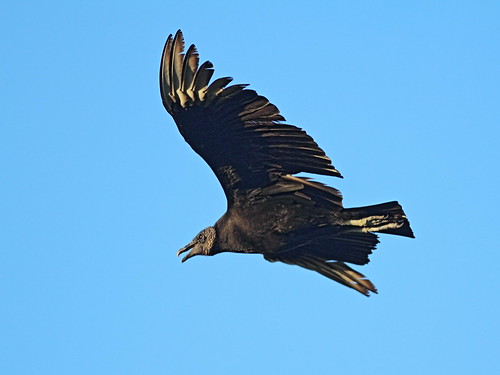
Sometimes an immature Bald Eagle may join a flock of vultures. Turkey Vultures have an exceptionally keen sense of smell. Until the eagle becomes fully competent as a hunter, it will often feed on carrion. A meal of roadkill may be its last, as many are struck by motor vehicles. This is a juvenile (first year) bird, as evidenced by its dark bill and bulging secondary wing feathers. Its head and tail will turn almost completely white when it is about four years old:
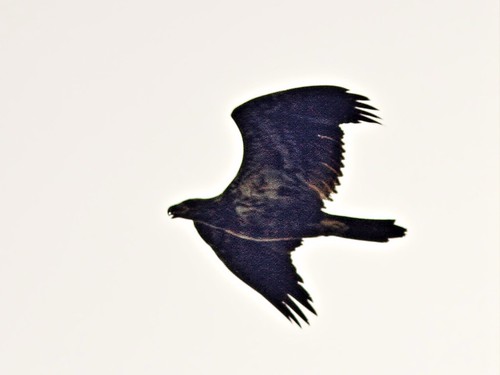
A few times I have identified a Short-tailed Hawk flying with vultures. The association may allow the hawk to escape detection before it drops like a stone to catch an unwary bird:
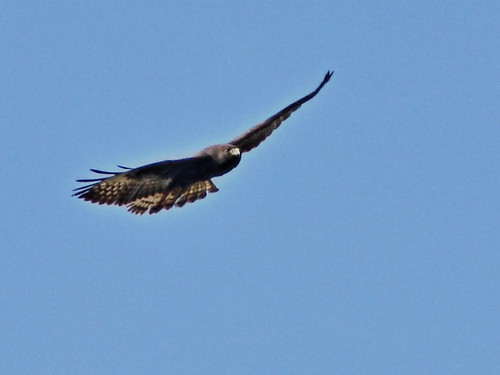

Fish Crows often loaf in the vicinity of the eagle nest, which if left unguarded may provide a meal of leftover prey, or worse, an egg or nestling. They can be distinguished from hawks and vultures by the fact that they almost never soar, beating their wings constantly as if "rowing a boat:"


We have enjoyed deliciously cool and clear mornings out on our local wetlands. Still air sets up beautiful reflections. From our shadowed vantage point on the lakeside marsh, we watch as the sun, rising in a cloudless sky, touches the pine bank on the opposite shore:
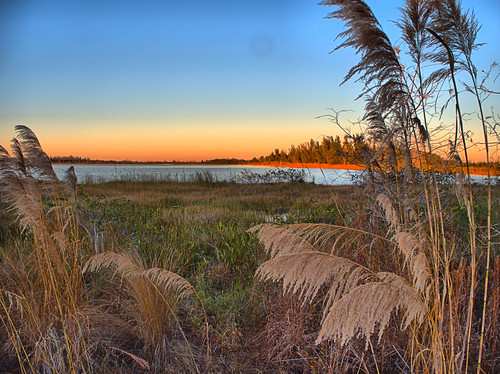
Mottled Ducks bask in full morning light:
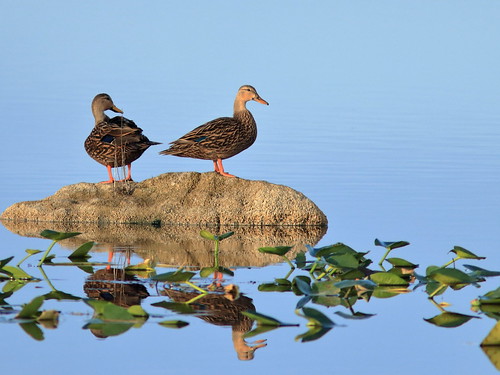
= = = = = = = = = = = = = = =
Linking to Misty's CAMERA CRITTERS,
Linking to Eileen's SATURDAY'S CRITTERS,
Linking to SKYWATCH FRIDAY by Yogi, Sylvia and Sandy
Linking to WEEKEND REFLECTIONS by James
Linking to BirdD'Pot by Anni
Linking to Our World Tuesday by Lady Fi
Linking to Wild Bird Wednesday by Stewart
Linking to Wordless Wednesday (on Tuesday) by NC Sue
Linking to ALL SEASONS by Jesh
________________________________________________
Please visit the links to all these memes to see some excellent photos on display
________________________________________________
































































